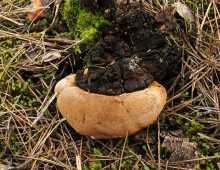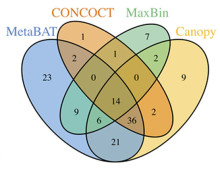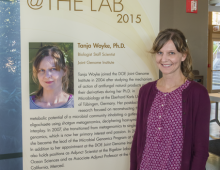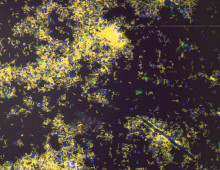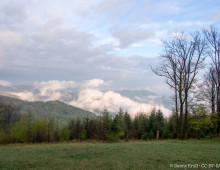Phakopsora pachyrhizi is responsible for Asian Soybean Rust (ASR) and is the major pathogen of soybean, causing severe losses in almost all soybean-growing areas. Nearly 300 billion tons of the legume are produced annually, and used primarily as feedstock and for bioenergy production. Yield damage caused by ASR can be dramatic (reported cases from 60…
Global Diversification of Pisolithus
The mutualistic ectomycorrhizal (ECM) fungal genus Pisolithus colonizes the roots of trees in forests around the world and are inoculated on bioenergy crops such as Eucalyptus sp. and Pinus sp. due to their role in promoting plant health and productivity under different environmental constraints. The mutualistic relationship between tree roots and ECM fungi, and the…
Methane cycling in arid and semi-arid ecosystems
Roughly one-third of the world’s land surface is characterized by severe water deficiency, and these semi-arid and desert areas around the world are currently expanding, impacting local and global climate. Very little is known about the microbial communities inhabiting the natural dry ecosystems, but environmental genetic studies showed that diverse and active bacteria inhabit arid soils,…
Better Microbial Genome Binning with MetaBAT
DOE JGI researchers develop an automated software tool that can scale to handle complex metagenome datasets. The Science: DOE JGI researchers have developed an automated tool called MetaBAT that automatically groups large genomic fragments assembled from metagenome sequences to reconstruct single microbial genomes. The Impact: The ability to accurately and efficiently reconstruct individual microbial genomes…
Tanja Woyke: 2015 Women @ Berkeley Lab Honoree
Tanja Woyke, head of our Microbial Program, was one of the honorees at Berkeley Lab’s 2015 Women @ The Lab, held November 18, 2015. She was among 14 women selected from labwide nominations in the following categories: Postdoctoral Fellow Early/Mid-Career Scientist or Engineer Senior Scientists or Engineer Operations Professional Administrative Professional Technician Click here to read about Dr. Woyke…
A History of Phage-Host Interactions With Help From CRISPRs
A tool to help microbial ecologists link phages to hosts in ecological studies. The Science: Using metagenomic datasets produced from the Iron Mountain site in Northern California and customized tools, researchers used bacterial spacer sequences commonly called CRISPRs to link phage and hosts in ecological studies. The Impact: Interactions between uncultivated microbes and their phage…
Erika Lindquist: Reflections of a Berkeley Lab Veteran
In observance of Veterans Day 2015, Erika Lindquist, our Sequencing QA/QC Group Lead who served in Iraq as a member of the California Army National Guard, appeared in a video produced by Berkeley Lab. She spoke about her deployment to Iraq, and most importantly, the lessons she has applied to life after military service. Watch Erika’s video at…
Building Off Known Genomes to Advance Systems and Ecosystems Biology
2016 Community Science Program proposals build upon DOE JGI-generated reference genomes. The U.S. Department of Energy Joint Genome Institute (DOE JGI), a DOE Office of Science User Facility, has announced that 27 new projects have been selected for the 2016 Community Science Program (CSP). “These new CSP projects, selected through our external review process, exploit…
A Single-Cell Pipeline for Soil Samples
Scientists evaluate a process that uses NanoSIMS and Raman microspectroscopy for in situ microbial studies. The Science: To investigate in situ function of uncultivated microbes, scientists evaluated a process for preparing soil samples for single-cell analysis methods. The Impact: The process allows researchers to efficiently analyze microbial activities at the single-cell level in soil systems,…
Studying Drought Tolerance in Sorghum
In the midst of a historic drought, the U.S. Department of Energy is funding a $12.3 million project in California to examine how environmental factors influence heritable changes in gene expression in one particular crop. The Epigenetic Control of Drought Response in Sorghum, or EPICON, focuses on understanding how sorghum, a grass related to corn,…
